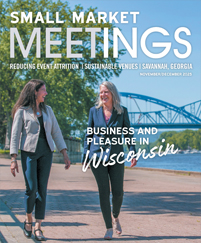In recent years, rising costs and falling memberships have led some organizations to look at co-locating their conferences or tradeshows to boost event profits. In theory, co-locating cuts costs, boosts attendance and promises attendees twice the value. In practice, it offers as many risks as rewards, especially if it’s not done correctly.
Here’s what experts say event planners and their organizations need to know about co-location.
Know Before You Co-locate
In simple terms, co-location is when two separate events, usually hosted by two organizations, are held in tandem. For example, a small association might host an evening event during a larger conference, or two organizations might have their trade shows at the same time in the same venue.
There are two primary goals of co-location. Organizations hope to save money and resources by splitting the cost of the venue and increase their event’s attendance by attracting their co-host’s audience.
The goals seem simple, but in reality they’re not always easy to achieve. Planning two events in tandem means twice the moving parts for planners to manage. Plus, the decision to co-locate is usually made by an executive team — a team that doesn’t always include event planners.
“My advice to any association is if you’re going to co-locate an event, each side needs to have their head of meetings in on the negotiations from the beginning,” said Ed Rigsbee, a public speaker and author who specializes in associations and strategic alliances. “Those people know what it’s going to take to make it work and have the in-depth knowledge.”
In addition to involving the planning team from the start, associations must realize that co-location is not an easy path to profit. It is a binding legal and financial partnership that requires both sides to make sure the partnership is a good fit. Without due diligence, an association can put itself at risk by partnering with an organization that isn’t well managed or financially secure.
“Look into their financial and operational health to check on who you will partner with,” said Valerie Bihet, owner of VIBE Agency. “Do due diligence. If you don’t have the same values and objectives, or if you don’t share the same audience or if you have some competing interests, don’t do it.”
Communication is Key
Clear communication is a hallmark of any successful event.
For the executives, this means a frank conversation to hammer out details early on. Roles and responsibilities must be defined, costs and labor divided, and goals and objectives set to avoid misunderstandings. That means contracts must be signed, conflicts and negotiations resolved and strategy agreed upon by both sides.
“When you’re getting into the nitty gritty and the roles aren’t clear, it can be pretty complex, and you can have lots of disputes,” said Dave Lutz, founder and president of Velvet Chainsaw Consulting, which specializes in business consulting for meetings. “It definitely is something that needs to be spelled out in the beginning.”
If two associations are co-locating their trade shows, event planners for both must continue to communicate with one another after initial negotiations. Talks should increase in frequency as the event draws nearer.
“It’s all about communication,” Rigsbee said. “Did Association A’s CEO communicate everything their meeting planner needs to know? Did Association B’s CEO communicate everything to his or her meeting planner that that person needs to know? Unfortunately, a lot of times the answer is ‘no.’”
Bihet recommends assigning task forces to handle various logistical components, such as production or content, and having these task forces meet on a regular basis.
“Make sure you have a collaborative plan,” said Bihet. “At the beginning, you can do some monthly or bi-monthly calls, then lead up to a weekly call.”
Talking with the other planning team keeps the partners’ event visions aligned and allows any red flags to be addressed. It also builds trust between the organizations.
“You have to realize that, nine times out of 10, if these things don’t work, it’s because of a trust issue,” Lutz said. “I’ve seen so many situations where it becomes an us-versus-them mindset.”
Being a Good Co-Host
When it comes to logistics of a co-located event, planners on both sides have twice the details to manage.
Scheduling can be a challenge. Partners must work together to ensure there are no conflicts in their agendas.
For example, if two trade shows co-locate and then have evening events on the same night, they limit the potential attendance at either event. Likewise, if each event has their keynote speaker scheduled at the same time, it eliminates the possibility of cross-engagement. Logistical issues — like limited equipment — should also be considered. A venue might not have enough A/V equipment to cover the needs of both events should the equipment be needed at the same time.
Partners must take care not to lose their brand identity when they co-locate. If it’s not obvious which components belong to which event, one brand will miss out on recognition.
“Be careful, because you can have brand confusion,” Bihet said. “Then you have brand misalignments and poor perception of one of the events, and it’s a diminished experience compared to the other event.”
A good sign for a successful co-location partnership is when two organization’s audiences overlap — but not too much. Co-locating events for organizations that have conflicts of interest or the same audience can become too competitive and take audience engagement from each other.
Good partners ensure every level of the team stays engaged. Because of the number of details involved, the team needs to be involved throughout. An absent partner can become a weak link.
“If you’re not going to do the work, it’s not going to go well,” Rigsbee said. “So you have to keep your interest level and participation all the way through at that same higher level.”
Even in an ideal partnership, there will be some hiccups. And at the end of the day, planners may need to give some grace and let go.
“You have to be pretty thick-skinned and realize if there’s a co-location, you’re not going to be in control of things you’d normally be in control of,” Lutz said. “You may have to look the other way and have more empathy.”












